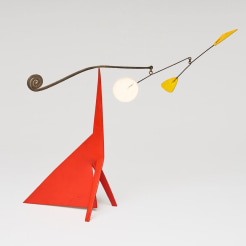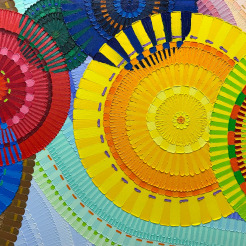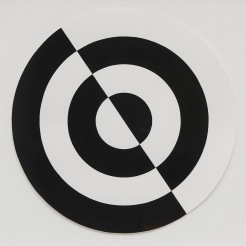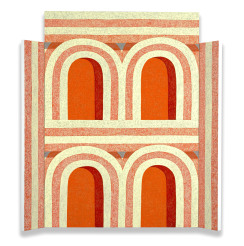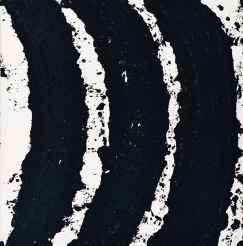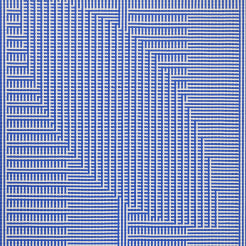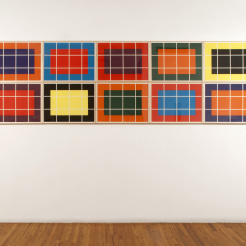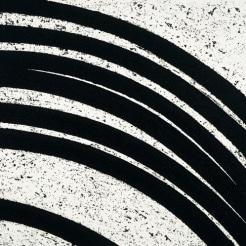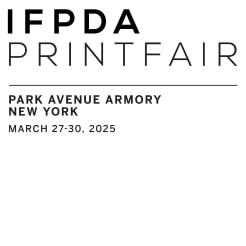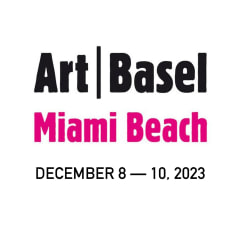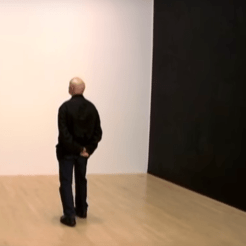Richard Serra was born November 2, 1939, in San Francisco. While working in steel mills to support himself, Serra entered the University of California, Berkeley and graduated in 1957 with a B.A. in English literature from the University's Santa Barbara campus. He then went on to study at Yale University, where by 1964 he had completed both his B.F.A. and M.F.A.
Serra trained as a painter at Yale, where he worked with Josef Albers on his book The Interaction of Color. During the early 1960s, he came into contact with Philip Guston, Robert Rauschenberg, Ad Reinhardt, and Frank Stella. In 1964 and 1965, Serra traveled to Paris on a Yale Traveling Fellowship, where he frequently visited the reconstruction of Constantin Brancusi's studio at the Musée National d'Art Moderne. He spent much of the following year in Florence on a Fulbright grant, and traveled throughout southern Europe and northern Africa.
The young artist was given his first solo exhibition at Galleria La Salita, Rome, in 1966. Later that year, he moved to New York, where his circle of friends included Carl Andre, Walter De Maria, Eva Hesse, Sol LeWitt, and Robert Smithson. In 1966, Serra made his first sculptures out of nontraditional materials such as fiberglass and rubber. From 1968 to 1970, he executed a series of "Splash" pieces, in which molten lead was splashed or cast into the junctures between floor and wall. Serra had his first solo exhibition in the United States at the Leo Castelli Warehouse, New York. By 1969, he had begun the prop pieces, whose parts are not welded together or otherwise attached but are balanced solely by forces of weight and gravity.
The Pasadena Art Museum organized a solo exhibition of Serra's work in 1970, and in the same year he received a John Simon Guggenheim Memorial Foundation fellowship. That year, he helped Smithson execute Spiral Jetty at Great Salt Lake in Utah; Serra, however, was less intrigued by the vast American landscape than by urban sites, and in 1970 he installed a piece on a dead-end street in the Bronx. He received the Skowhegan Medal for Sculpture in 1975 and traveled to Spain to study Mozarabic architecture in 1982. Serra was honored with solo exhibitions at the Kunsthalle Tübingen, Germany, in 1978; the Musée National d'Art Moderne, Paris, in 1984; the Museum Haus Lange, Krefeld, Germany, in 1985; and the Museum of Modern Art, New York, in 1986. The 1990s saw further honors for Serra's work: a retrospective of his drawings at the Bonnefantenmuseum, Maastricht; the Wilhelm Lehmbruck prize for sculpture in Duisburg in 1991; and the following year, a retrospective at Museo Nacional Centro de Arte Reina Sofía, Madrid.
In 1993, Serra was elected a fellow of the American Academy of Arts and Sciences. In 1994, he was awarded the Praemium Imperiale by the Japan Art Association and an Honorary Doctor of Fine Arts degree from the California College of Arts and Crafts, Oakland. Serra has continued to exhibit in both group and solo shows in such venues as Leo Castelli Gallery and Gagosian Gallery, New York. He continues to produce large-scale steel structures for sites both in the United States and Europe. In 1997–98, his "Torqued Ellipses" were exhibited at the Dia Center for the Arts, New York.




